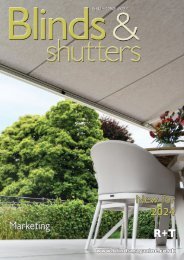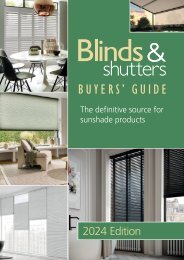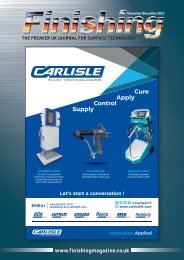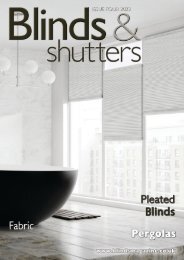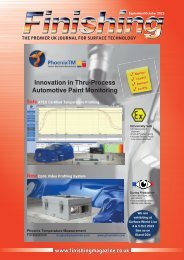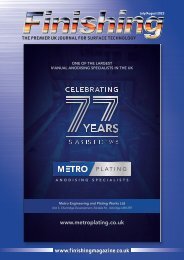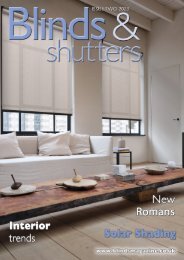Blinds & Shutters Buyers Guide 2023
Welcome to the Blinds & Shutters Buyers’ Guide 2023 the only UK directory for blinds, shutters, awnings and grilles. This is the essential guide for manufacturers, retailers and specifiers such as architects and designers, to source components and finished products. This edition of the Buyers’ Guide contains useful and practical information, such as the revised Glossary that starts on page 5. In the Year in Review starting on page 26, we take a look at the issues that dominated the headlines. On page 28 the Smart Buildings Show 2022, proved to be the biggest and best yet! Features on new products start on page 30, whilst the BSI revised some of the Relevant Standards, and this section can be found on page 113. The A-Z Section and Buyers’ Guide Section provides information relating to 450 businesses and 50 different product types. We hope that you find this year’s directory an invaluable aid to sourcing suppliers to provide the solution to your specific needs.
Welcome to the Blinds & Shutters Buyers’ Guide 2023 the only UK directory for blinds, shutters, awnings and grilles. This is the essential guide for manufacturers, retailers and specifiers such as architects and designers, to source components and finished products.
This edition of the Buyers’ Guide contains useful and practical information, such as the revised Glossary that starts on page 5. In the Year in Review starting on page 26, we take a look at the issues that dominated the headlines. On page 28 the Smart Buildings Show 2022, proved to be the biggest and best yet! Features on new products start on page 30, whilst the BSI revised some of the Relevant Standards, and this section can be found on page 113.
The A-Z Section and Buyers’ Guide Section provides information relating to 450 businesses and 50 different product types.
We hope that you find this year’s directory an invaluable aid to sourcing suppliers to provide the solution to your specific needs.
You also want an ePaper? Increase the reach of your titles
YUMPU automatically turns print PDFs into web optimized ePapers that Google loves.
GLOSSARY<br />
Timer Control – a daily or weekly timer to<br />
operate the blinds at preset times. It is<br />
usually used to extend the blinds in the<br />
morning and retract them at night. Where<br />
blinds or shutters are used for insulation it<br />
can be used to lower them at night for<br />
heat retention.<br />
Light level control – for non-retractable<br />
blinds has three lux level control and allows<br />
the slats to adjust to maintain light levels<br />
within a selected band width.<br />
Master or Building Control – allows<br />
override of the system from one central<br />
point with the option of an interface<br />
with the fire alarm system to retract the<br />
blinds.<br />
Individual control – allows override of the<br />
automatic system by a switch local to each<br />
blind.<br />
Infra-red control – operation by means of an<br />
infra-red transmitter that activates the<br />
sensor that is normally mounted on the<br />
wall beside the blind.<br />
Radio remote control – control by a hand<br />
held transmitter is usually used for shutters<br />
or garage doors. It is suited when direct line<br />
of sight to the sensor is not possible.<br />
ELECTRIC OPERATION<br />
Almost all types of blinds and shutters can<br />
be electrically operated (motorised). For<br />
venetian blinds, the motors are located within<br />
the headrail section; for roller blinds and<br />
smaller shutters, the motors are tubular and<br />
fit within the roller; on vertical blinds, the<br />
motor is mounted on the back of the track.<br />
Non-retractable<br />
rooflight blinds<br />
have the motors<br />
mounted on one<br />
of the racks<br />
above the slats.<br />
For larger shutters, the motor is mounted at<br />
the end of the roller and drives to the roller<br />
through gears. This type of externally fitted<br />
motor, which is usually 3-phase, is also used<br />
for folding and commercial up-and-over<br />
doors.<br />
Small 12v motors are also available for<br />
small blinds. As they are normally battery<br />
operated, a qualified electrician is not<br />
required for the wiring.<br />
Generally, installers and fitters of blinds<br />
and shutters will not undertake mains<br />
wiring as part of their contract, as this must<br />
be carried out by a qualified electrician.<br />
Normally this work is done by the site<br />
electrician or an electrician familiar with the<br />
client’s building. Thus electrical items are<br />
usually supplied only.<br />
The blind fitter is responsible for final<br />
testing and commissioning and setting the<br />
motor operating limits. Usually the blinds are<br />
installed and tested from an independent<br />
power source before handing over to the<br />
contractor.<br />
Motors are normally supplied with a<br />
1 metre length of flex (or flying lead) so it is<br />
necessary for a junction box or plug<br />
connection to be located within 1 metre of<br />
the end of the blind. Where more than one<br />
blind operates from a single switch, relays<br />
must be used and they can also serve as<br />
junction boxes. Most motors are single<br />
phase using normal 3 core mains supply<br />
cable to the switch, but the cable from the<br />
switch to the motor is 4 core. There are 2<br />
wires for supply (one for raise and one for<br />
lower) a neutral and an earth. The load<br />
requirement is normally not more than an<br />
amp for each motor.<br />
FABRIC LAMINATING<br />
AND PROCESSING<br />
Lamination is the conversion of fabrics to fit<br />
a different use or application. Fabrics such as<br />
silks or chenilles that are too delicate can<br />
benefit from laminating a knit to the back.<br />
This process increases the fabric strength,<br />
durability and seam integrity. It also<br />
minimizes fraying.<br />
Lamination processes can also be used<br />
for fabric protection, fire protection, liquid<br />
protection and saving time and money in<br />
sewing and upholstering.<br />
Lamination processes include: Water Base<br />
Adhesives, Hot Melt Adhesives, Dry Web<br />
Adhesives, Plastisol Adhesives and Flame<br />
Bonding.<br />
Types of lamination<br />
Fabric to fabric - Typically for processes<br />
other than upholstery, but can be. This<br />
process will greatly increase a fabrics<br />
durability while intending to increase the<br />
hand or stiffness.<br />
Acrylic backing - Used to prevent fraying<br />
and to keep fabric from slipping over the<br />
foam.<br />
Fire retardancy - Fabric treatment to comply<br />
with state and federal fire codes.<br />
Soil resistance - Fluorocarbon treatment to<br />
your fabric to prevent staining.<br />
Blackout backing - Most commonly used to<br />
back window covering and shade fabric.<br />
Used to block out ultraviolet rays. Can be<br />
laminated to your fabric to create window<br />
shades.<br />
Foam backing - Laminating foam to the back<br />
of fabric. Commonly used for padding,<br />
sound attenuation, acoustics and quilting.<br />
Canvas backing - Used to increase the<br />
durability of almost any fabric.<br />
Laminated Roller <strong>Blinds</strong> are made by<br />
laminating a stiffened backing cloth, either<br />
standard or blackout (white or cream) to<br />
the face material. This method is particularly<br />
suitable for glazed chintz, silk, moirés,<br />
synthetics, loosely woven fabrics and any<br />
material that has joins for wide blinds. Any<br />
fabric that has been treated for stain<br />
resistance or fire retardancy needs to be<br />
laminated. It is not suitable for fabrics with a<br />
high synthetic content.<br />
Base shapes and/or borders to the base<br />
& sides can be applied to laminated roller<br />
blinds.<br />
A Processed Roller Blind is created by<br />
stiffening the face fabric with a special<br />
silicone solution. Processing is most suitable<br />
for voile, lace and untreated cotton &<br />
cotton mix fabrics. It is not suitable for silks,<br />
fabrics with a high synthetic content or<br />
fabrics with metal threads in the weave.<br />
Types of processing<br />
Die Cutting, Sheeting, Slitting, and Re-rolling.<br />
NO SEW ROMAN<br />
FABRIC<br />
Fabric that can be knifed without risk of<br />
fraying, and used un-hemmed, in the<br />
manufacture of Roman blinds.<br />
24 <strong>Blinds</strong> & <strong>Shutters</strong> <strong>Buyers</strong>’ <strong>Guide</strong> • <strong>2023</strong>




